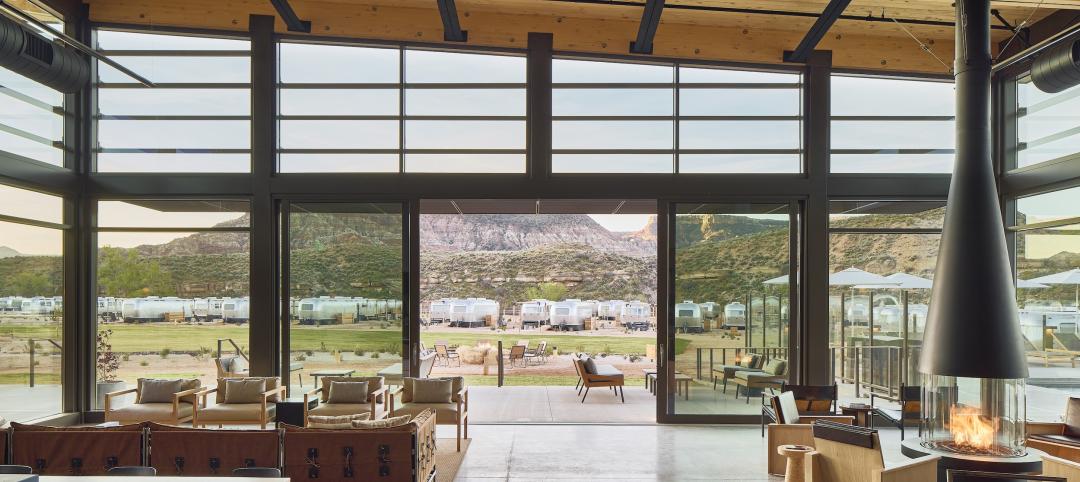There is one thing that every sailor in the U.S. Navy shares with every other sailor: For the first eight weeks of their Navy careers, every one of them will have gone through basic training at Camp John Paul Jones, Naval Station Great Lakes, in North Chicago, Illinois. Every year, more than 40,000 young men and women graduate from the Recruit Training Camp, en route to assignments around the world.
For the last three years or so, recruits have spent a considerable amount of their boot camp training in the Atlantic Fleet Drill Hall, a 56,840-sf facility designed by Wight & Company, Darien, Ill., that achieved LEED-NC v2.2 Gold, the first Navy construction project to earn that award. Recently, I was given a tour of the facility by Lt. Vincent Dasta, USN, Atlantic Fleet Commander, to inspect the sustainable aspects of the project.
The Navy, through its construction arm, the Naval Facilities Engineering Command (NAVFAC), was an early leader in green building among Federal departments. In fact, the Bachelor Enlisted Quarters at the Great Lakes Naval Training Center (also designed by Wight) was the first U.S. government project to be LEED certified, earning LEED-NC v1.0 Bronze in 2000—practically at the birth of LEED. Currently, the Navy requires all applicable projects to achieve a minimum LEED Silver rating.
Construction of the drill hall was part of a large-scale plan to modernize and upgrade facilities at Camp John Paul Jones, according to Dasta. “When we reorganized the base, this building fit in really well,” says Dasta. “This is the headquarters of the Atlantic Fleet, and we try to simulate to the recruits what the Fleet Navy is like.” Instead of using the term “barracks” for living quarters, the camp is divided into five “ships,” and the entry to the drill hall is known as the quarterdeck.
The massive drill hall itself is “a big, open space, very flexible, but the details make it useful to us,” says Dasta. It is used for physical training, drill exercises, and weekly Olympic-style sports competitions. The recruits are assigned to 14 divisions of 88 sailors; the drill hall can hold 10 divisions comfortably for marching exercises, says Dasta, but it can handle the full complement of divisions.
One of the major uses of the space is for running, and the resilient floor provides a pliant surface to reduce stress on recruits’ knees. The runners’ direction is reversed every day to keep the floor from developing a wear pattern. The facility is open 24/7, so it gets a great deal of use.
Dasta says the drill hall’s combined daylighting, lighting control, and shade control system has worked well over the last three years to keep the facility at a comfortable temperature while providing the health benefits associated with sunlight. Elsewhere in the drill hall are offices, a conference room, and classrooms.
Maintaining the building has been easy, according to Dasta. “Sustainment of facilities has become a big push in the last year or so, with the completion of the last of our major buildings” at Camp John Paul Jones.
The LEED Gold rating was achieved while conforming to the Navy’s Base Exterior Architectural Plan, which provides guidelines for upgrading the overall appearance of Navy shore facilities.
Key LEED milestones: a 41.7% reduction in water use and a 37.2% reduction in energy over a conventionally designed building. High-efficiency air-cooled water chillers with non-CFC refrigerant, energy recovery coils, and a direct digital control system for operator-programmable systems were employed, as well as occupancy sensors and scheduling to control outdoor air. The Building Team even anticipated the U.S. Green Building Council’s requirement for data collection on LEED projects by installing meters in the drill hall.
Other green elements: a solar white standing-seam metal roof, a motorized window shading system to control heat gain, and a five-year maintenance program for building operations, maintenance, and repairs.
The joint venture contractor of Pacific Construction Services and Old Veteran Construction Services Inc. (the latter a “service-disabled, veteran-owned” business) achieved an 89.6% rate of diversion of construction waste from landfill.
“We used a lot of smart conventional equipment to achieve the goals for the project,” says Lois Vitt Sale, AIA, LEED Faculty, and SVP/Chief Sustainability Officer at Wight & Company. BD+C
Low-impact Development Guides Stormwater Plan
Site planning for the Atlantic Fleet Drill Hall at Naval Station Great Lakes utilized the concept of low-impact development, or LID, to control stormwater runoff.
According to Tom Powers, PE, LEED AP, CRM, CPESC, a project manager with Wight, the basic principle of low-impact development is to model stormwater systems after nature—to manage rainfall at the source, using distributed small-scale stormwater management systems.
The goal, says Powers, is to “mimic the site’s hydrology as it existed before development began, using stormwater features that infiltrate, filter, store, evaporate, and detain runoff close to its source,” with particular attention to smaller, more frequent storms. Major infrastructure improvements at Camp John Paul Jones were designed to handle the much larger 100-year storms.
Since December 2007, with the passage of the Energy Independence and Security Act, controlling runoff is not a choice in almost all Federal construction projects. EISA states that “any development or redevelopment project involving a Federal facility with a footprint that exceeds 5,000 sf shall use site planning, design construction, and maintenance strategies for the property to maintain, or restore, to the maximum extent technically feasible, the predevelopment hydrology of the property with regard to the temperature, rate, volume, and duration of flow.” That pretty much mandates low-impact development for Federal projects.
The strategy for the Atlantic Fleet Drill Hall site had three prongs: 1) disconnect impervious areas where possible; 2) filter and infiltrate the average annual runoff; and 3) reduce nonpoint runoff through the use of native plantings.
The drill hall is situated on top of a small hill, with the building itself representing the largest source of concentrated stormwater runoff on the site. Under LID principles, the stormwater treatment areas were also located close to the building. The drill hall does not have a basement, so it was possible to excavate below-grade infiltration zones around the four corners of the building and fill them with gap-graded stone to create catchment basins with a 40% void ratio.
According to Powers, the roof runoff is then piped into the upper-layer infiltration zones and the water is allowed to percolate down through the stone following the groundwater gradient. The stormwater is daylighted and discharged to the infiltration zones via perforated pipes connected to the downspouts. The underground catchments are designed to hold a one-year 24-hour storm event and most of a two-year event; any spillover gets directed into the regional system and ultimately into the base detention facility.
For the bulk of the site, says Powers, the landscaping choice was to go with native plantings and buffalo grass, whose root systems can extend as far as eight feet deep into the soil, as opposed to only a few inches for Kentucky bluegrass. Buffalo grass needs only a quarter-inch of water per week and does not require mowing, pesticides, or fertilizers. Not having to irrigate the buffalo grass and other native decorative plantings contributed to the 41.7% reduction in water use for the drill hall compared to a conventional project. Moreover, buffalo grass grows to a maximum height of about five inches in the Great Lakes region and therefore does not present a security problem, which is important in a military facility.
Without the LID plan, the one-acre site would have had an unrestricted runoff rate of 6-7 cfs, says Powers. With LID, that has been reduced to 1.77 cfs for a one-year 24-hour storm and 2.03 cfs for a two-year storm. “We captured all the one-year storms and 99% of the two-year storms, and that’s before you count in the benefit of the buffalo grass,” says Powers.
Related Stories
Sponsored | Building Enclosure Systems | May 16, 2023
4 steps to a better building enclosure
Dividing the outside environment from the interior, the building enclosure is one of the most important parts of the structure. The enclosure not only defines the building’s aesthetic, but also protects occupants from the elements and facilitates a comfortable, controlled climate. With dozens of components comprising the exterior assemblies, from foundation to cladding to roof, figuring out which concerns to address first can be daunting.
Multifamily Housing | May 16, 2023
Legislators aim to make office-to-housing conversions easier
Lawmakers around the country are looking for ways to spur conversions of office space to residential use.cSuch projects come with challenges such as inadequate plumbing, not enough exterior-facing windows, and footprints that don’t easily lend themselves to residential use. These conditions raise the cost for developers.
Headquarters | May 16, 2023
Workplace HQ for party clothing company Shinesty celebrates its bold, whimsical products
The new Denver headquarters for Shinesty, a party clothing company, was designed to match the brand’s fun image with an iconic array of colors, textures, and prints curated by the design agency, Maximalist. Shinesty’s mission, to challenge the world to live more freely and “take itself less seriously,” is embodied throughout the office interior.
Office Buildings | May 15, 2023
Sixteen-story office tower will use 40% less energy than an average NYC office building
This month marks the completion of a new 16-story office tower that is being promoted as New York City’s most sustainable office structure. That boast is backed by an innovative HVAC system that features geothermal wells, dedicated outdoor air system (DOAS) units, radiant heating and cooling, and a sophisticated control system to ensure that the elements work optimally together.
Life of an Architect Podcast | May 15, 2023
Life of an Architect Podcast Ep. 125: What Makes a Great Employee?
How do you define a great employee? The answer is most likely dependent on who is attempting to respond: the employee or the employer. Life of an Architect's Bob Borson, FAIA, and Andrew Hawkins, AIA, talk about the traits and characteristics of great employees.
K-12 Schools | May 12, 2023
In Virginia, a new high school building helps reimagine the experience for 1,600 students
In Virginia, the City of Alexandria recently celebrated the topping out of a new building for Alexandria City High School. When complete in 2025, the high-performance structure will accommodate 1,600 students.
University Buildings | May 11, 2023
New ‘bold and twisting’ building consolidates School of Continuing Studies at York University
The design of a new building that consolidates York University’s School of Continuing Studies into one location is a new architectural landmark at the Toronto school’s Keele Campus. “The design is emblematic of the school’s identity and culture, which is centered around accelerated professional growth in the face of a continuously evolving labor market,” according to a news release from Perkins&Will.
Sustainability | May 11, 2023
Let's build toward a circular economy
Eric Corey Freed, Director of Sustainability, CannonDesign, discusses the values of well-designed, regenerative buildings.
Hotel Facilities | May 9, 2023
A new camping destination near Utah’s Zion National Park offers a variety of all-season lodgings and amenities
Outdoor lodging brand AutoCamp has opened a new camping destination near Utah’s Zion National Park. A 16-acre property, AutoCamp Zion is located between the Virgin River and the desert of Southern Utah.
Headquarters | May 9, 2023
New Wells Fargo development in Texas will be bank’s first net-positive campus
A new Wells Fargo development in the Dallas metroplex will be the national bank’s first net-positive campus, expected to generate more energy than it uses. The 850,000-sf project on 22 acres will generate power from solar panels and provide electric vehicle charging stations.

















